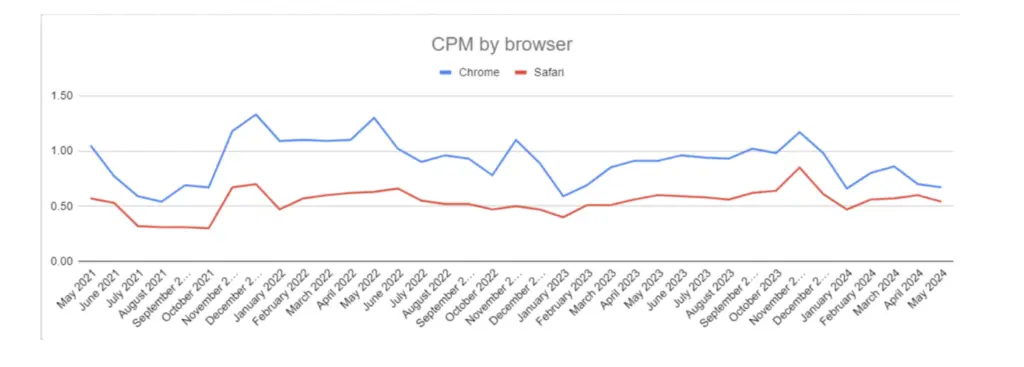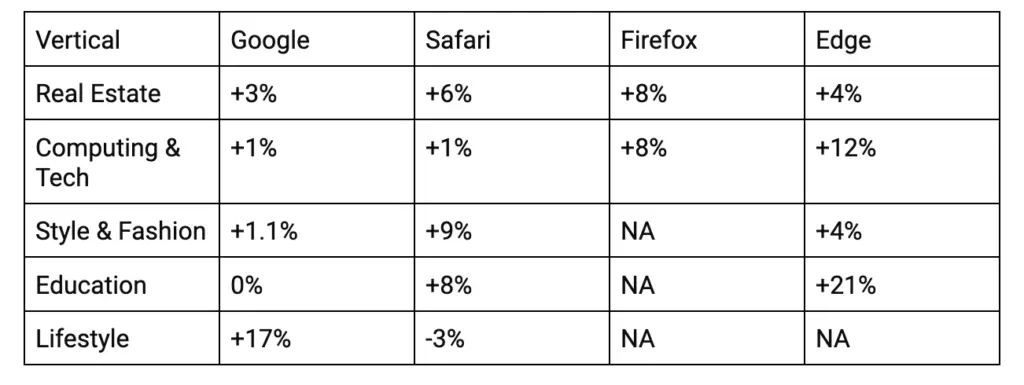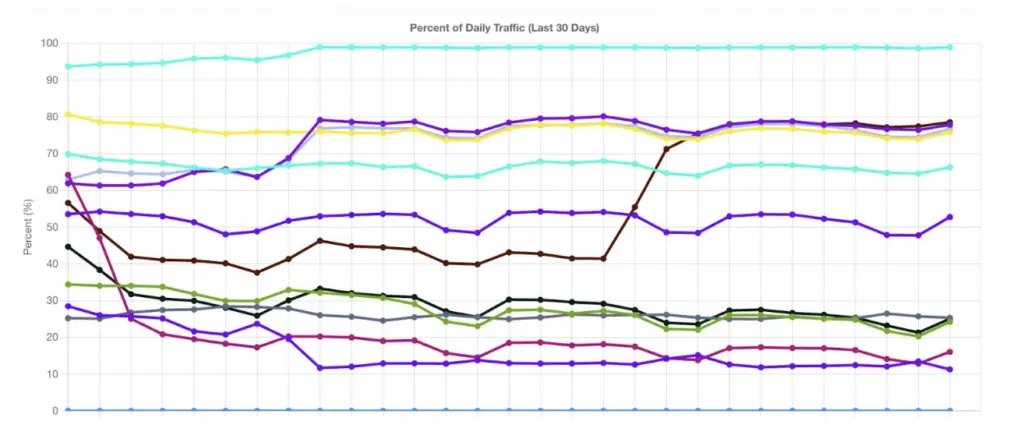While Google’s recent decision regarding third-party cookies might seem like a reprieve for publishers, the reality is more nuanced. Google’s recent announcement might actually be the final nail in the coffin for third-party cookies, putting the choice in users’ hands. This is similar to the iOS ‘Do Not Track’ prompt, where 96% of users opted out of sharing their device ID, effectively ending that tech for Apple devices. With this big change on the horizon, publishers must adapt quickly and strategically to keep their edge. While third-party cookies remain, their effectiveness for ad targeting is already hampered by factors like:
- Browser Fragmentation: With an estimated 50% of open market impressions now non-targetable due to restrictions in browsers like Safari and Firefox, the advertising ecosystem is already operating in a partially cookieless environment.
- User Choice: Google’s plan to introduce new privacy controls for Chrome users mirrors the iOS ‘Do Not Track’ prompt, where an overwhelming 96% of users opted out of sharing their device ID. This shift towards user-centric privacy controls could further limit the reach of third-party cookies.
- Regulatory Pressure: Increasing privacy regulations and potential federal legislation in the U.S. are pushing the industry towards more privacy-conscious practices.
- Declining CPMs: The limited coverage of third-party cookies has already led to a significant drop in CPMs by nearly 50% for Safari and Firefox users, which is likely to continue.
It’s not just Google’s latest news driving the need for better first-party data practices. Those with strong first-party data are in a prime position to benefit. Here’s why:
Consumer Expectations: Consumers are getting more control over their data. Publishers can use this trend to build trust and offer better experiences. Knowing your readers better through first-party data helps create stronger loyalty and personalized content.
Privacy Changes: The landscape of data privacy is changing fast. Different state laws and talks of federal regulation in the U.S. mean publishers must up their game in data privacy and compliance. Creating safe data environments with clean rooms and data marts is becoming essential. This shift allows publishers to leverage their data while positioning themselves as privacy leaders safely.
Publishers as Ecosystems: Publishers are moving away from relying on platforms like Google and Meta by building their data-rich ecosystems. Big publishers use partnerships to connect their online, offline, and transactional data, improving reader connections across channels. Smaller publishers are following suit, aiming to strengthen their first-party data.
Understanding the Landscape of Alternative IDs
Publishers need effective identification solutions as privacy regulations and consumer demands evolve. This change affects ad targeting and revenue. Adapex’s Data Refinery offers a diversified approach to enhance data precision and compliance.
Publishers need effective identification solutions as privacy regulations and consumer demands evolve. This change affects ad targeting and revenue. Adapex’s Data Refinery offers a diversified approach to enhance data precision and compliance. Not only does our Data Refinery provide all the tools necessary for the future, but it also delivers an immediate uplift to your programmatic impressions.
In the quest for better targeting, publishers face many alternative ID solutions like Unified ID 2.0 and email-based IDs. Each has its pros and cons, and there’s no one-size-fits-all solution. Performance varies based on browser compatibility, vertical focus, and coverage. So, your data strategy needs to be multifaceted.
The Impact of ID Performance on Publisher Revenue:
There are many ways to view Google’s announcement regarding third-party cookies. From a consumer perspective, choice and control are positive; they empower the consumers. However, from a publisher’s perspective, this adds to the uncertainty.
What is certain is that third-party cookie coverage will continue to decline. If Google sets the default to “block cookies,” it is likely to follow the 96% reduction in cookies experienced when Apple set its defaults in Safari. Without these cookies, the value of Safari users for ad targeting significantly decreased. This situation highlights a crucial point: publisher revenue hinges on the performance of identification solutions, regardless of Google’s cookie strategy. The CPM gap is narrowing as we approach cookieless targeting on Google and as more universal IDs are injected into the bid request.

The Importance of Alternative IDs
Given this risk, the performance of alternative ID solutions becomes crucial. These methods directly impact key metrics like RPM (Revenue per Mille). Without effective alternatives, publishers face significant revenue shortfalls.
(RPM gauges the value of your pages by dividing total revenue by pageviews and multiplying by 1000. RPM is a comprehensive metric including earnings from all ad units on a page, helping publishers assess their full revenue-generating potential.)
Results from Adapex’s Data Refinery show RPM uplifts from +5-15% on Safari and +1-4% on Google, which still allows the third-party cookie on 99% of their traffic. For a publisher with 1 million page views per month and an average bid of $0.60, an RPM uplift of 5% can result in additional monthly revenue gains of $15,000 across the identity solutions So, the annual revenue gains would range from $36,000 to $180,000 depending on the percentage of RPM uplift.
Key Insight:
Despite Google’s decision to retain third-party cookies, their effectiveness is already compromised. Publishers must prioritize alternative ID solutions and robust first-party data strategies to safeguard revenue and adapt to ongoing changes in digital advertising.
The Case for Multiple IDs: Why Putting All Your Eggs in One Basket is Risky
Relying on a single ID solution is risky. Publishers should adopt a diversified approach, using multiple IDs to reduce risks and maximize revenue.
A key part of this strategy is incorporating first-party data. As privacy concerns grow, first-party data becomes more valuable.By using insights directly from your audience, you can gain a deeper understanding of user behavior and preferences. This leads to more personalized and targeted ads, driving higher engagement and revenue.
Combining first-party data with alternative IDs boosts monetization efforts and strengthens the publisher-user relationship. It builds trust and transparency, showing users content and ads relevant to them. First-party data also provides a solid foundation for identity resolution, ensuring accuracy across platforms and devices.
Real Results: Adapex’s Data Refinery:
Adapex’s Data Refinery is a solution backed by a proven track record. It’s been developed and refined over three years, supported by data showing its effectiveness.
With consistent revenue uplifts, Data Refinery helps publishers thrive in the digital landscape. Its impact spans all browsers, with notable results on Google and Safari. Data Refinery is more than just an alternative—it’s a reliable solution that boosts revenue growth for publishers.
Sample Revenue Uplifts by Vertical by Browser

Coverage by ID

Here, we observe that various ID solutions exhibit differing coverage rates, representing the percentage of users they can successfully match. This variance in coverage can be attributed to several factors, including the matching methodology employed (deterministic vs. probabilistic), and the browsers they focus on, among others. It’s important to note that a low coverage rate for an ID solution doesn’t necessarily imply poor performance.
For instance, an ID solution with a coverage rate of 1% could significantly enhance CPMs or achieve better fill rates. Conversely, ID solutions with nearly 100% coverage might exist but only a marginal 1% increase in CPM.
Conclusion
Forget third-party cookies. The future of publisher revenue lies in building a strong foundation of first-party data. By leveraging insights directly from your audience, you unlock a treasure trove of information about their behavior and preferences. This empowers you to create personalized experiences and targeted advertising, fostering user loyalty and driving engagement.
Moreover, a robust first-party data strategy positions you as a leader in data privacy compliance. This builds trust with your audience, a critical asset in a world increasingly concerned about user privacy.
The Path to Success: Smarter Data Management
Preparing for the future isn’t just about generating more first-party data. It’s about finding the best ways to unlock your publication’s data potential through smarter aggregation, enrichment, and partnerships. This multifaceted approach ensures you’re maximizing the value of your data while adhering to privacy regulations.
- Data Aggregation: Consolidate data from various sources, like website visits, app usage, and surveys, to gain a holistic view of your audience.
- Data Enrichment: Enhance your data by adding additional information from external sources, demographics, or purchase history (with user consent) to create richer user profiles.
- Partnerships: Collaborate with other publishers or data providers to expand your reach and access new audience segments.
This approach will help your publication thrive in a more regulated, transparent, and collaborative data landscape. Connecting your best data with identity-based solutions across partners and channels will yield significant benefits now and in the future.
Embrace a Future Focused on Privacy
At Adapex, we prioritize privacy. Our solutions are designed with privacy at their core because it’s the right approach. The digital landscape has evolved, and consumer privacy must drive our innovations. Compliance with regulations like GDPR and CCPA is essential. Transparency and consent are critical in handling first-party data. User trust is the cornerstone of sustainable digital advertising.
We ensure our data practices meet the highest standards by adhering to current regulations and preparing for future changes. We’re always here to help and can share our results and experience to lead you to success.
By prioritizing first-party data, adopting a diversified approach with identity solutions, and implementing smarter data management practices emphasizing transparency and user consent, you’ll be well-positioned to navigate the evolving advertising landscape and build strong relationships with your audience.













